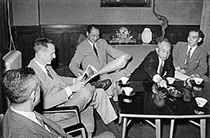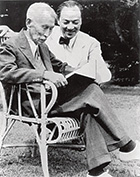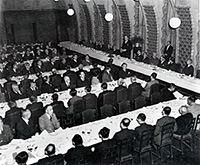The International House of Japan, Inc. was established on August 27, 1952. Its origins date back to an encounter between John D. Rockefeller, 3rd and Matsumoto Shigeharu at the third conference of the Institute of Pacific Relations held in Kyoto in 1929. Having experienced diverse cultures and peoples, they recognized the importance of the cultural dimension within international affairs, which tended to be viewed primarily in political and economic terms. They worked together for the rest of their lives, dedicated to the promotion of international understanding through cultural exchange and to the rebuilding of postwar US-Japan cultural relations.
 Rockefeller and Matsumoto
Rockefeller and Matsumoto at the preparatory meeting
In 1951, Rockefeller visited Japan again in a delegation headed by John Foster Dulles, who had been assigned by President Truman to negotiate the peace treaty, and submitted the report “United States-Japan Cultural Relations” to Dulles. It included far-sighted recommendations for both the public and private sectors: creation of a “culture center” in each country and intellectual exchange programs.
 Kabayama Aisuke (left)
Kabayama Aisuke (left) and Matsumoto Shigeharu
Feeling the Rockefeller Foundation’s support for such projects indispensable, Rockefeller hurried back to Tokyo and met with Japanese intellectuals including Kabayama Aisuke to develop the concept for a “culture center” in Tokyo. Stimulated by his ideas, a Cultural Center Preparatory Committee was organized and successful in getting approval for funding the project with support from the foreign community and many individuals, which led to the founding of the International House later on.
 Tea reception inaugurating
Tea reception inaugurating
the House fund-raising campaign
Having thought that “cultural center” and “international house” should be pursued under the same conceptual umbrella, the committee decided on the former estate of Koyata Iwasaki of the Mitsubishi business empire, located in the heart of Tokyo, as the physical site. This property, with a traditional Japanese garden, had been turned over to the government by the Iwasaki family as tax payment, and Matsumoto successfully negotiated with Finance Minister Ikeda Hayato to obtain it. The construction of the House building, jointly designed by three leading Japanese architects, Maekawa Kunio, Sakakura Junzo, and Yoshimura Junzo, took about one year to complete. Having not waited for its completion to resume Japan's cultural contacts, Rockefeller donated $100,000 to Columbia University for the Intellectual Interchange Program. This consisted of two committees, one set up at Columbia’s East Asian Institute and the other in Tokyo, chaired by Takagi Yasaka of the Tokyo Imperial University. The program brought to Japan the “top-rate American intellectuals” whose absence Matsumoto had long lamented. The International House was open officially on June 11, 1955, and became, as intended, a crossroad for intellectuals from the world.

 Home
Home





